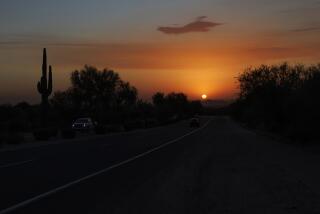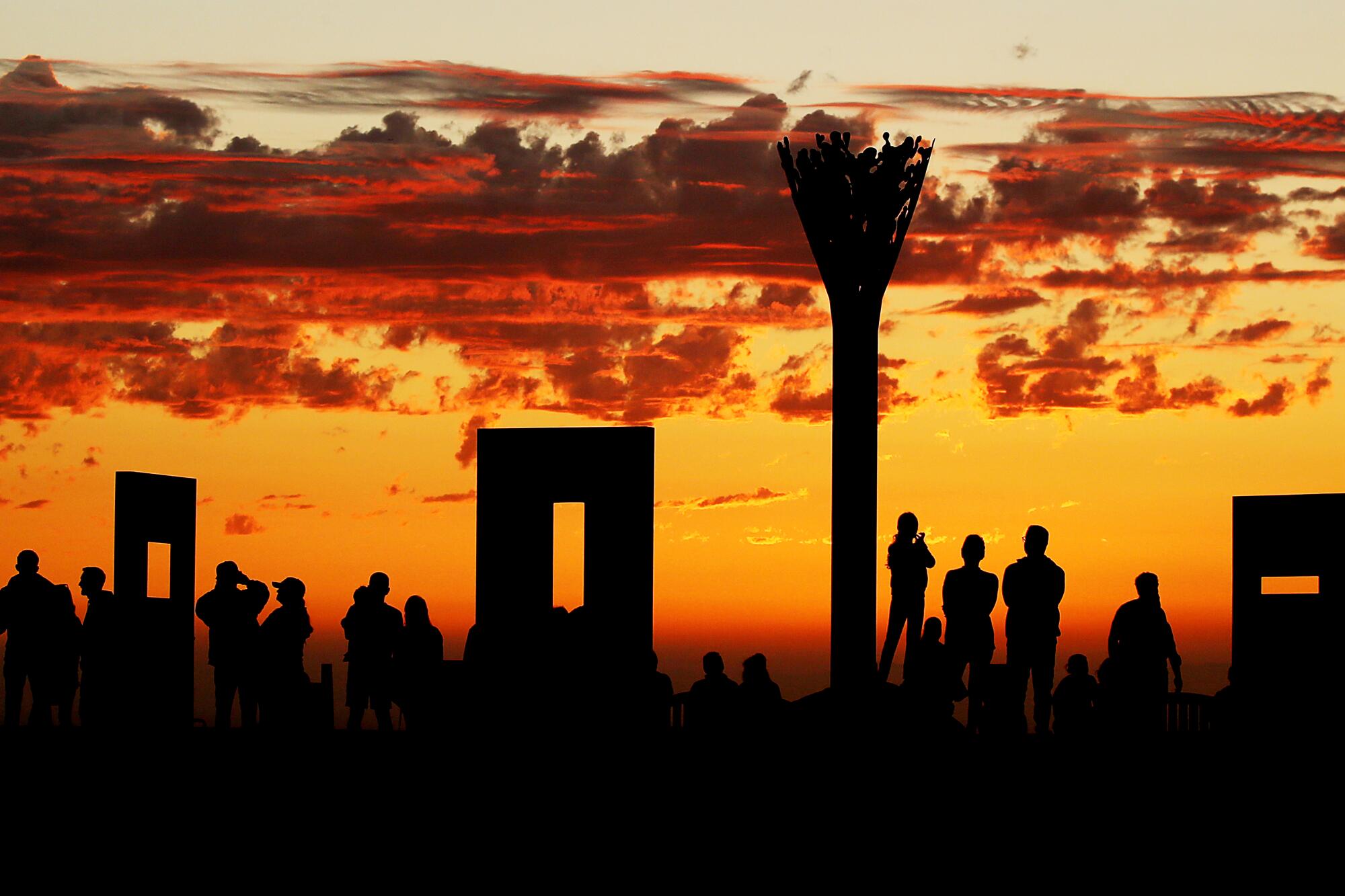
NEW BRAUNFELS, Texas — A Californian suddenly transported to this south Texas town on a Sunday morning, just in time for the service at the Tree of Life evangelical church, might be hard-pressed to know she wasn’t in California anymore.
California has more megachurches than any other state, so the nature of the congregation wouldn’t provide the tip-off. Rows of pickup trucks in the large parking lot might be a tell, but the percentage of Texans who drive trucks is actually around the national average.
Even if the Californian began asking for political opinions, she’d still have trouble proving she was in Texas.
“We’re a diverse congregation,” said Kristen Kallus-Guerra, a congregant who serves as a greeter at the church doors. “Around the election, our pastor always reminds us to go out and vote — but he doesn’t tell us who to vote for.”
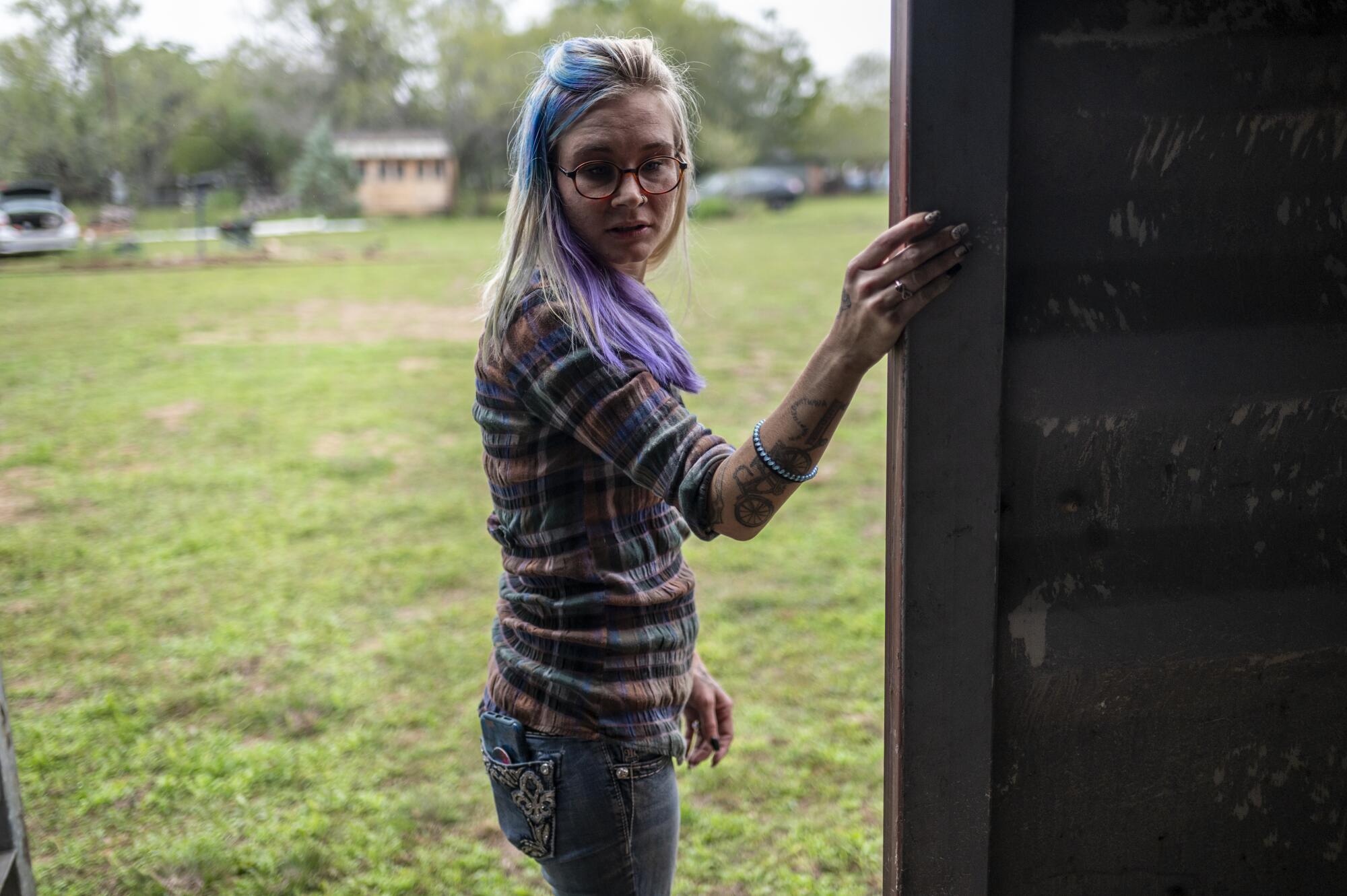
The most obvious evidence that the Tree of Life Church was in Texas would be the number of Dak Prescott jerseys. At least five congregants wore the Dallas Cowboys quarterback’s No. 4 uniform to church on a recent November morning.
The diversity of Texas can surprise people used to viewing the state through the lens of its very conservative public policies.
1
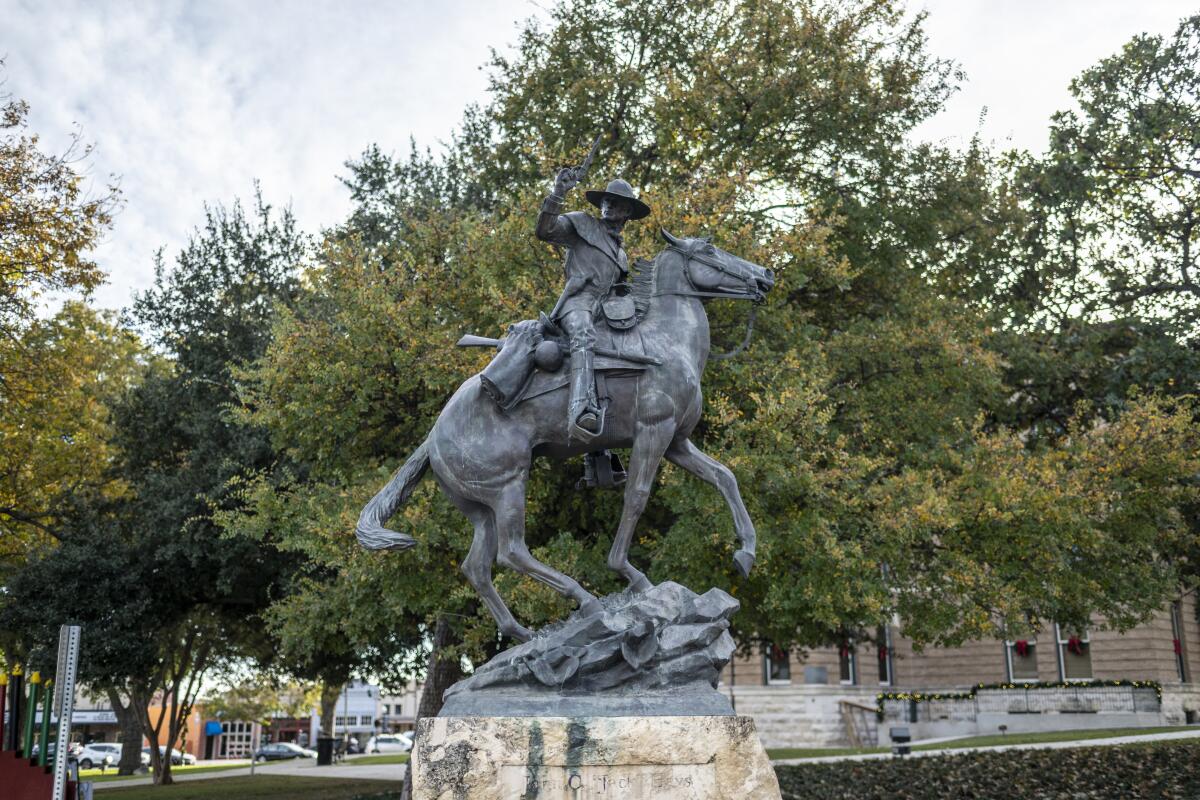
2
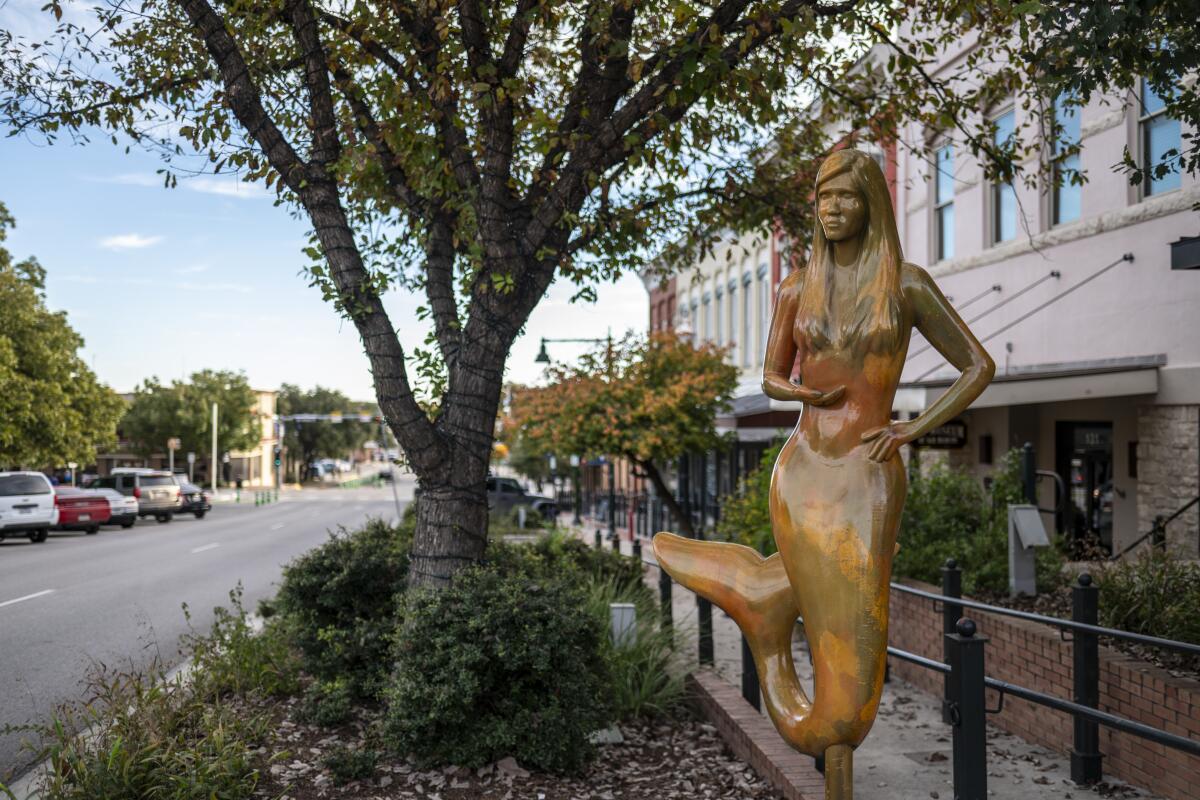
3
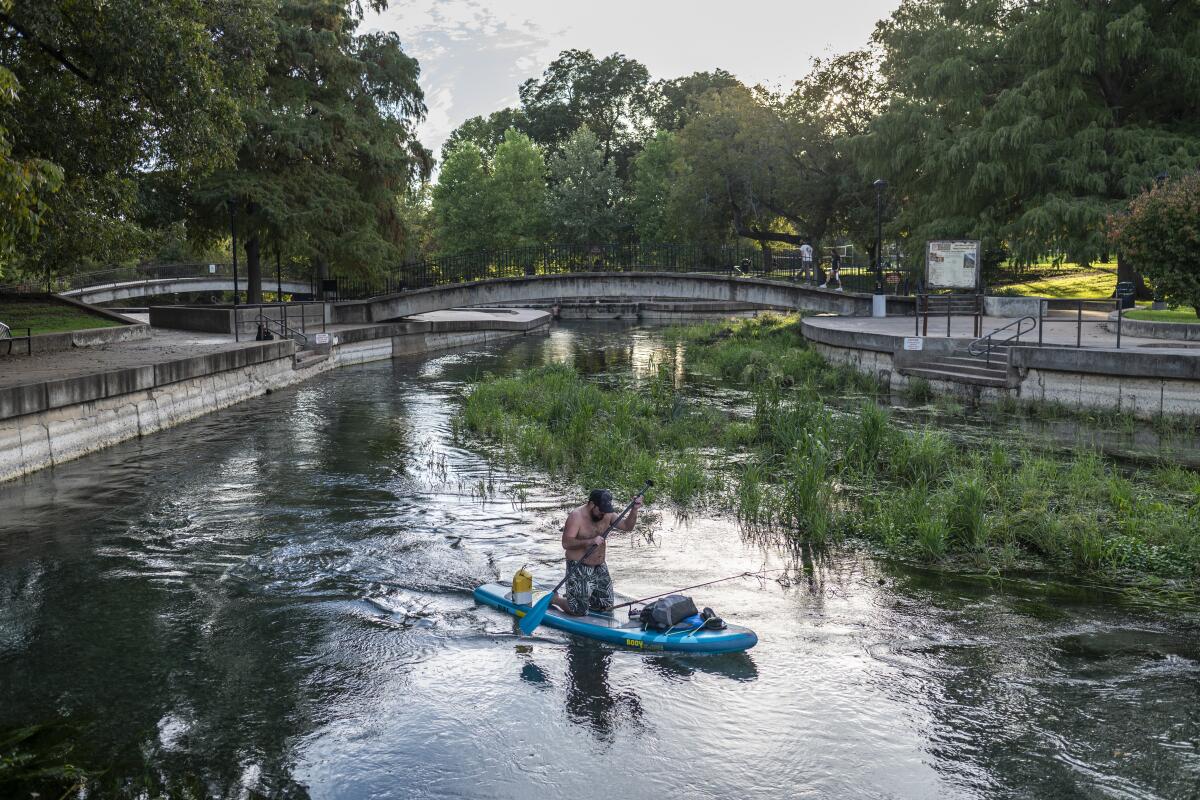
1. A statue of Captain John Coffee Hays. 2. A mermaid statue in San Marcos, Texas. 3. A person steers a paddleboard through the San Marcos River in San Marcos. (Sergio Flores / For The Times)
The people of the two states do not differ nearly as much as their governance, according to a poll of roughly 1,600 California and Texas residents, conducted by YouGov for the Los Angeles Times.
Subscribers get early access to this story
We’re offering L.A. Times subscribers first access to our best journalism. Thank you for your support.
California versus Texas is a rivalry without parallel. The nation’s two most populous states are political opposites — the liberal bastion on the left coast, and the conservative Southern garrison on the Gulf.
California fervently protects abortion rights; Texas bans nearly all abortions. Texas upholds gun rights; California strictly regulates firearms. California plans to ban new gasoline-powered cars by 2035; Texas has banned companies that divest from fossil fuels from doing business with the state.
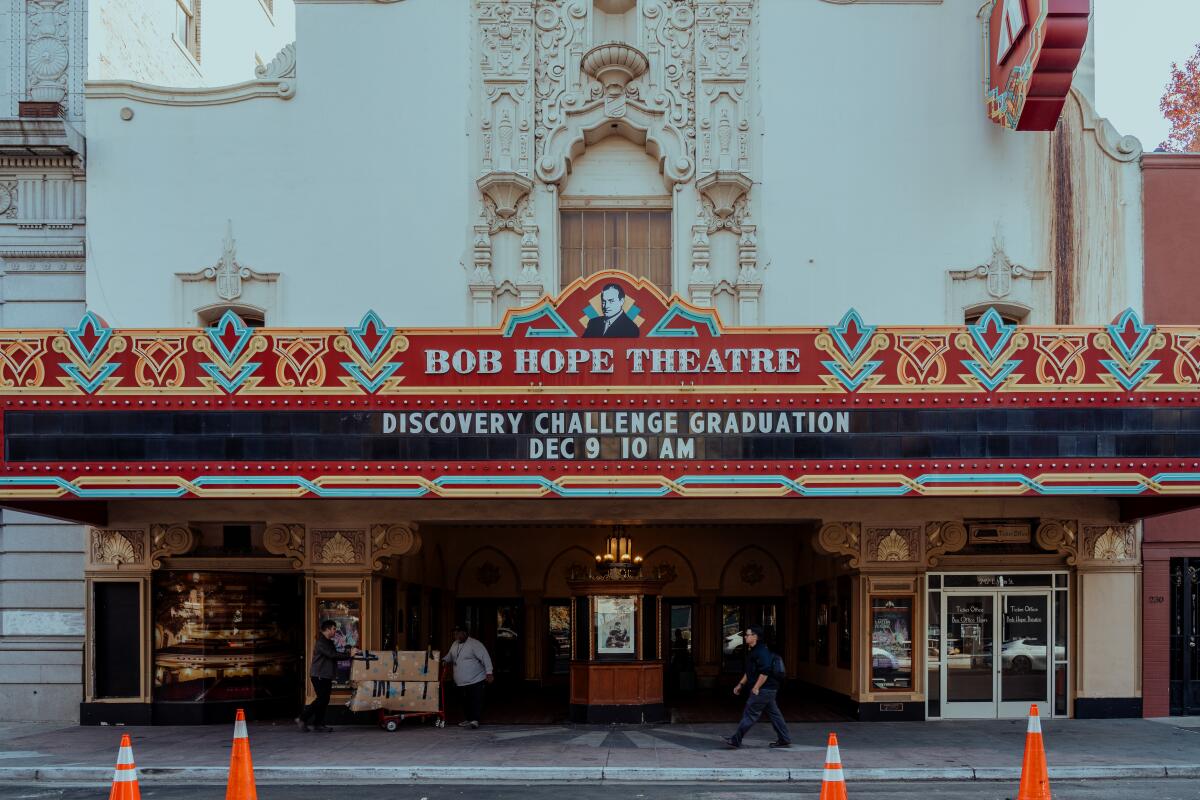
The Bob Hope Theater in downtown Stockton. (Andri Tambunan / For The Times)
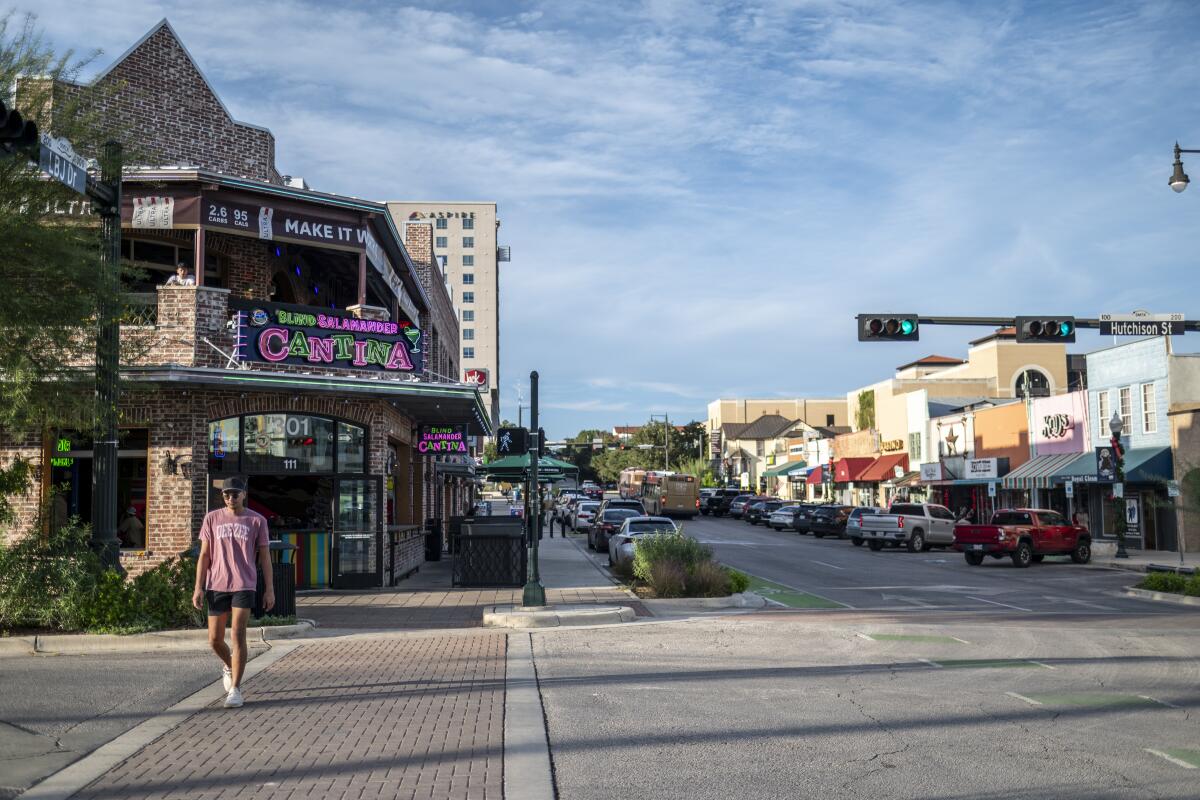
People walk through downtown in San Marcos, Texas. (Sergio Flores / For The Times)
But a plurality of respondents in both California and Texas identified as moderates — 32% of Californians, and 31% of Texans — the poll found. Moderate can mean very different things to different people, but on specific policy questions, residents of the two states were often surprisingly close.
Asked if government should do more to solve problems and help the needs of people, majorities in both states said yes — 61% of Californians and 55% of Texans. The opposing view, that government does “too many things better left to businesses and individuals” was only a bit more popular in Texas, 34%, than in California, 26%.
Asked about government benefits, 55% of Californians and 50% of Texans agreed that “poor people have hard lives because government benefits don’t go far enough to provide a decent standard of living.”
Even on the most hot-button issues — abortion, same-sex marriage, climate change — the poll found that the differences between Californians and Texans came down to a difference that’s fewer than 10 percentage points.
The poll shows that one demographic group has an outsized impact in widening the political gulf between the two states — white residents, who also are more likely to vote than other racial groups. Religious belief is a major factor in why white residents of Texas and California hold opposing views, the poll indicates.
Overall, the poll illuminates one of the central aspects of America’s political divide: Rather than huge splits in public opinion, the gap between America’s quintessential red and blue states comes down to tipping points.
Texans, on average, lean a few points to the right, Californians, a few more points to the left. Those leanings tip politics in each state, empowering conservative Republicans in Texas and liberal Democrats in California who have driven policy in opposite directions, magnifying differences between two states that otherwise have much in common.
***
If it weren’t for their political reputations, it might be easier to see California and Texas as twins, not foils.
Both western states, with their dramatic landscapes, used to be part of Mexico; both have brutal colonial pasts, with Spaniards and later Americans waging wars of removal against Native peoples. The early economies of California and Texas were defined by cattle and agriculture and later oil. In the last few decades, California, and increasingly Texas, have benefited from a boom in tech and venture capital.
Latinos make up the largest group in both states, a little over 40% of the population in each, according to the most recent Census. Non-Latino white residents are a minority in both states (34.7% of the population in California and 39.8% in Texas).
Subscriber Exclusive Alert
If you're an L.A. Times subscriber, you can sign up to get alerts about early or entirely exclusive content.
You may occasionally receive promotional content from the Los Angeles Times.
Texans are more rural — or more likely to label their communities that way: 30% of Texans, but just 15% of Californians, say they live in a rural area or small town, the poll found. Half of Californians, but just a third of Texans, say they live in an urban area.
It’s easy to forget that as recently as the 1990s, Texas was a mostly Democratic state. Democratic control began to crumble in the 1980s, but only ended in 1994 with the political ascension of a popular governor and heir to a political dynasty: George W. Bush.
Bush’s rise set the tone for Texas politics over the next three decades. Take guns, for instance.
When Bush ousted Democratic Gov. Ann Richards, it was still illegal to own a handgun in Texas. The year before that election, after the bloody battle in Waco between law enforcement agents and a religious cult known as the Branch Davidians, Richards vetoed a bill that would have made handguns legal. In his campaign, Bush used that veto as a wedge issue.
It proved highly successful. Thirty years later, Texans can legally carry concealed handguns in public — without any license.
***
California moved in the opposite direction over roughly the same period.
Several issues spurred political organizing that helped drive the state to the left: Then-Gov. Pete Wilson’s campaign in 1994 for Proposition 187, a ballot measure aimed at cutting off social services to unauthorized immigrants, increased voter registration and mobilization among Latino residents. A revived labor movement led to growing union power and influence — about 1 in 5 California residents have a union member in their family, roughly twice the level in Texas, the poll found.
Few issues, however, have had more grassroots impact on the state than environmentalism.
When he was 4, Jeremy Terhune’s family moved from Kansas to Stockton.
In the early ‘90s, as Terhune grew up, Stockton blended more seamlessly into the ranch and farmland of California’s Central Valley. But in the last 20 years, Stockton has transformed. With a population of 322,000, it has absorbed thousands of residents priced out of the Bay Area.
1
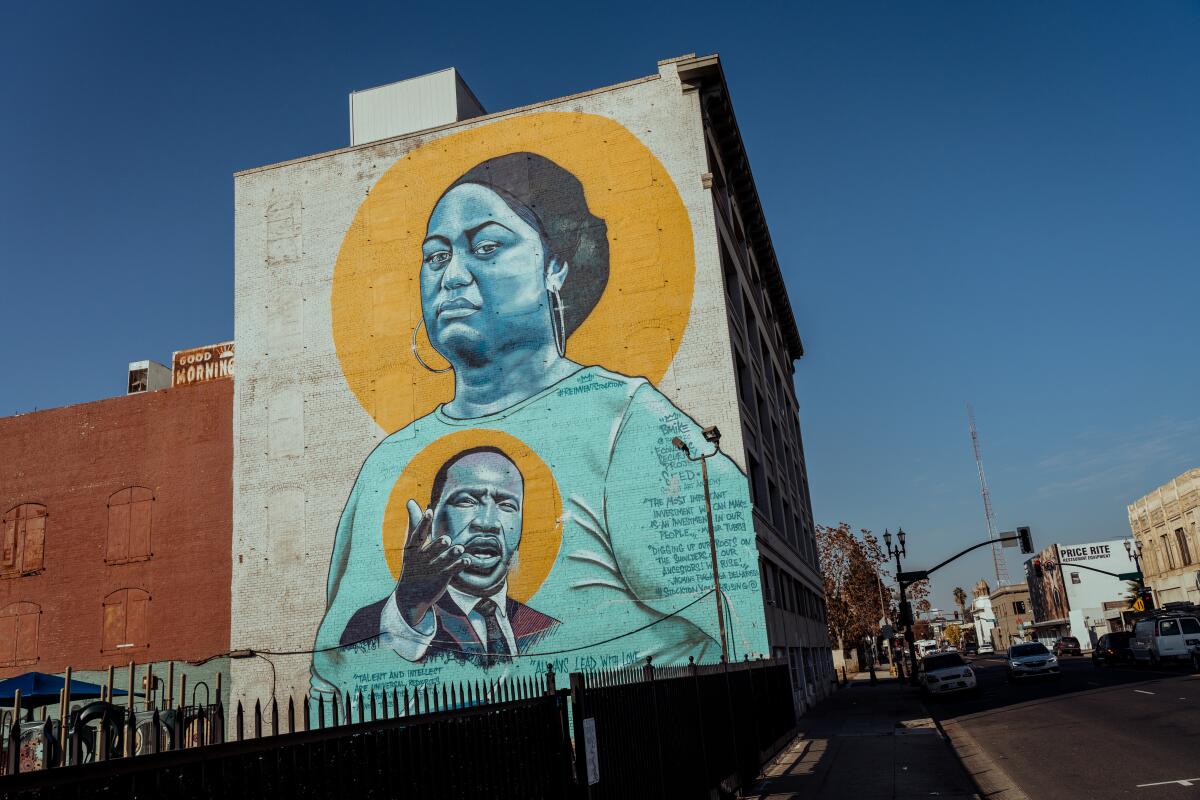
2
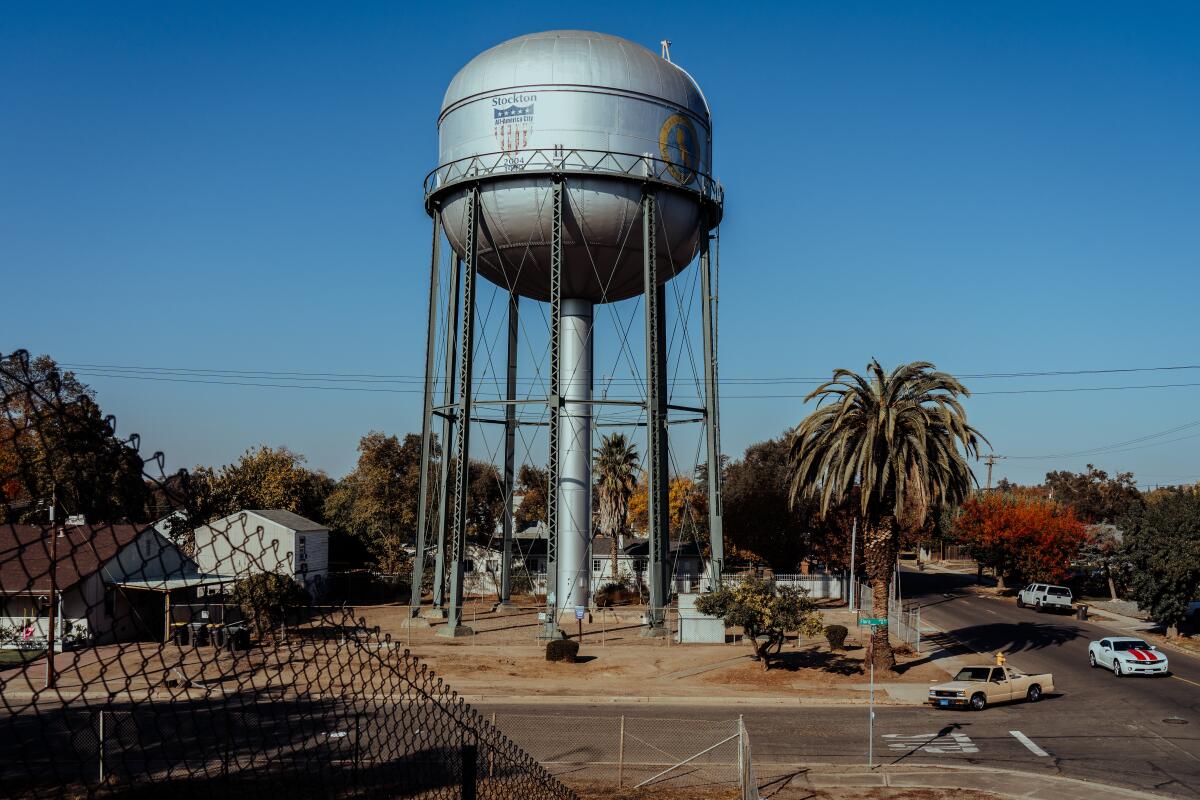
3
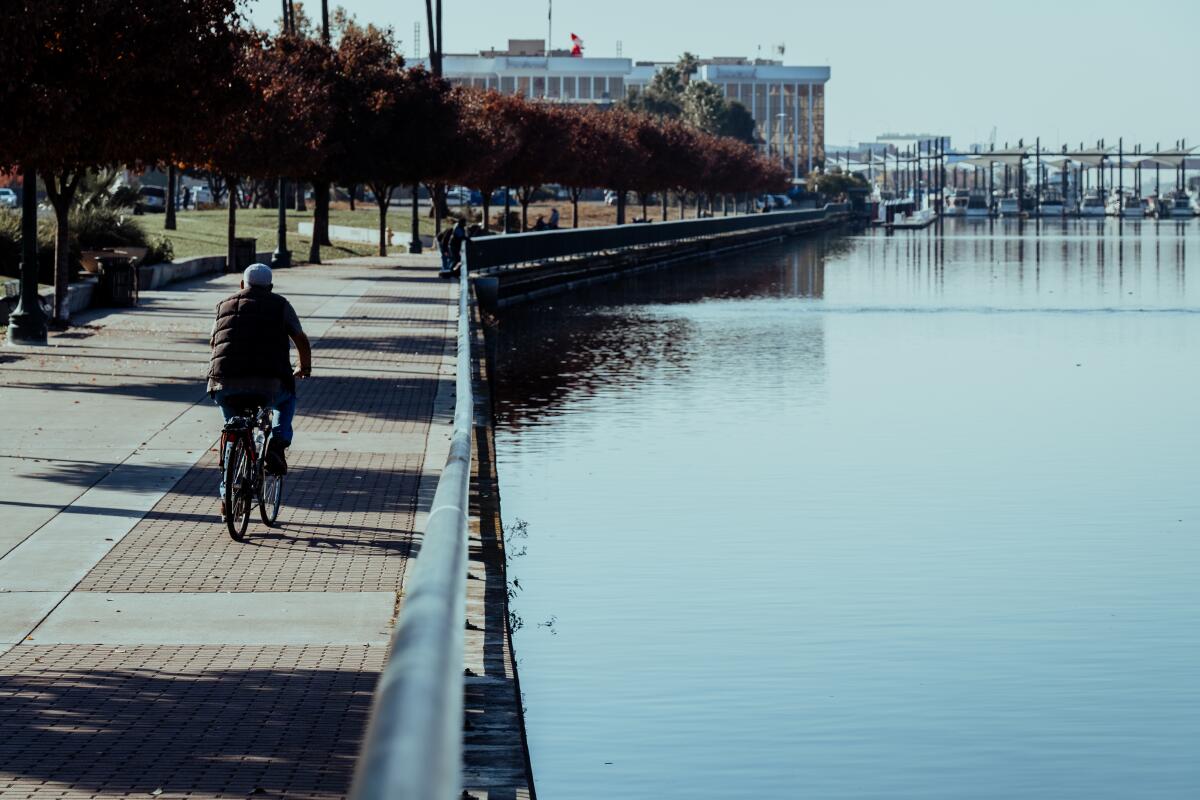
1. A giant mural in a Stockton schoolyard pays tribute to Jasmine DellaFosse, a Stockton youth organizer, and incorporates an image of the Rev. Martin Luther King Jr. 2. Stockton’s iconic water tower, which is owned by the California Water Service Co. 3. A man rides his bicycle on the Joan Darrah Promenade in Stockton’s downtown marina. (Andri Tambunan / For The Times)
Stockton is hard to define. It is, by some measures, the United States’ most racially diverse city. While more liberal than the surrounding counties of the Central Valley, the city still elected a Republican mayor in 2020 (albeit in a nonpartisan election).
Terhune has spent more time thinking about Stockton’s political values than most. For over a decade, he worked as a community organizer with environmental groups in Stockton and the valley.
He had to learn a key lesson.
“You have to start by asking questions; you have to meet people where they’re at,” Terhune said. “When it comes to people who aren’t what some call traditional environmentalists — like farmers, or hunters, or even the Latino community — I start by asking how they recreate. Where they get outdoors, even if it’s just a park.”
Terhune’s work culminated in founding PUENTES, an organization dedicated to making underserved communities environmentally healthier and more sustainable. The organization’s biggest victory was founding Boggs Tract Community Farm, a large urban garden in a predominantly Black neighborhood.
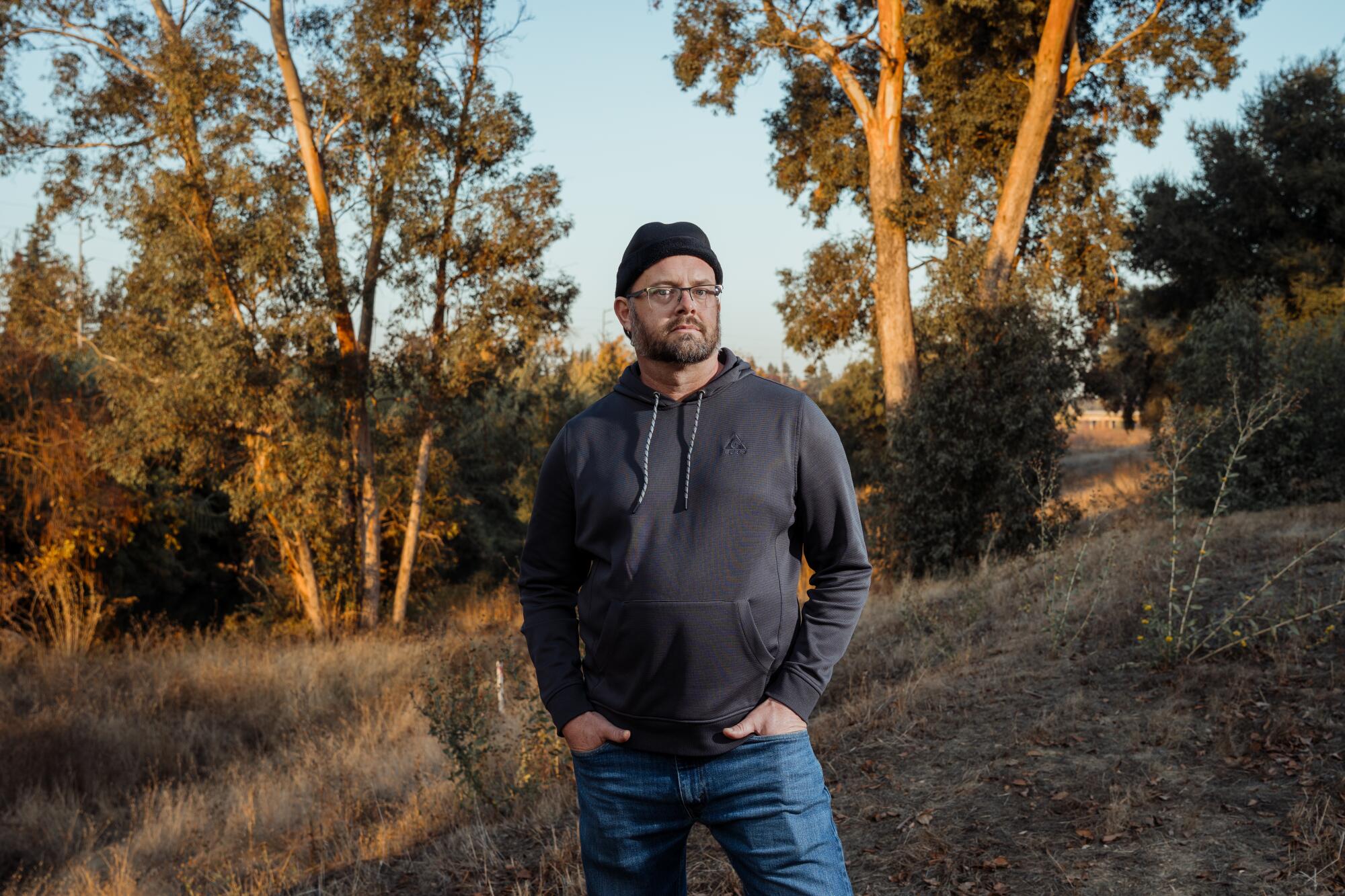
“We took a garbage dump, got the soil tested, and converted it into an organic farm,” Terhune says. “Now all of a sudden, everybody’s a gardener— suddenly urban gardening is a thing in Stockton.”
Efforts like that have made environmental values a major part of California culture. As the Democratic Party nationally embraced environmentalism, and the Republicans moved away from it, that helped cement the state’s Democratic identity.
The impact can be seen in how California residents view climate change — 70% say climate change is a “serious” issue, including just over half, 51%, who call it “very serious.”
In Texas, by comparison, 62% call the issue serious, but only a minority, 42%, said it was very serious.
Terhune points to a century-long history of community organizing to explain why California is culturally green: the Sierra Club was founded in San Francisco in 1892.
As the environment changes in Texas — the state just had one of its hottest summers in history in the midst of a exceptional drought — attitudes there might change as well, Terhune suggests. He points to the devastating 2021 February winter freeze, which brought the state’s electrical grid to the point of collapse.
“I think Texans are just as environmental and just as engaged in environmental justice as we are,” Terhune says. “But it’s about making that connection — and [after these storms] people are more aware of the environment.”
***
Like Stockton, New Braunfels has gone through a period of explosive change — it’s one of the fastest-growing places in the country, with a population of roughly 100,000. It’s the sort of place that will define Texas’ future.
Once rural ranchland, New Braunfels has been transformed into a bustling suburb between two of the country’s largest cities — San Antonio is about 20 minutes south, and Austin is 40 minutes north.
That makes New Braunfels the sort of place where aspects of Texan culture collide — and that includes politics.
San Antonio and Austin each went heavily for Joe Biden in the last election, and rural Texas went strongly for Donald Trump. New Braunfels was something of a swing district.
Of course, politics aren’t the only thing that makes the culture of New Braunfels diverse.
At the Tree of Life Sunday service, the choruses to the worship songs were sung in English and Spanish. The Latino — Tejano, more specifically — influence of south Texas is clearly present.
After the 75-minute service on the first weekend in November, Kallus-Guerra sat chatting with other members of the congregation.
With the outline of the state tattooed behind her right ear, Kallus-Guerra is proud to be Texan, although she says she has trouble defining what precisely being Texan means.
Texas identity matters in this state — 50% of residents said that being a Texan was a “big part” of their identity, compared with 44% of Californians who felt that way about their state. That’s true even though the share of people who are recent arrivals is significantly higher in Texas than in California.
“As far as like California-Texas, they can be different, sure,” she said. “But everyone has differences.”
Kallus-Guerra has met enough first-time churchgoers coming through the doors that she recognizes that some things about people — their needs, their yearnings — are more universal.
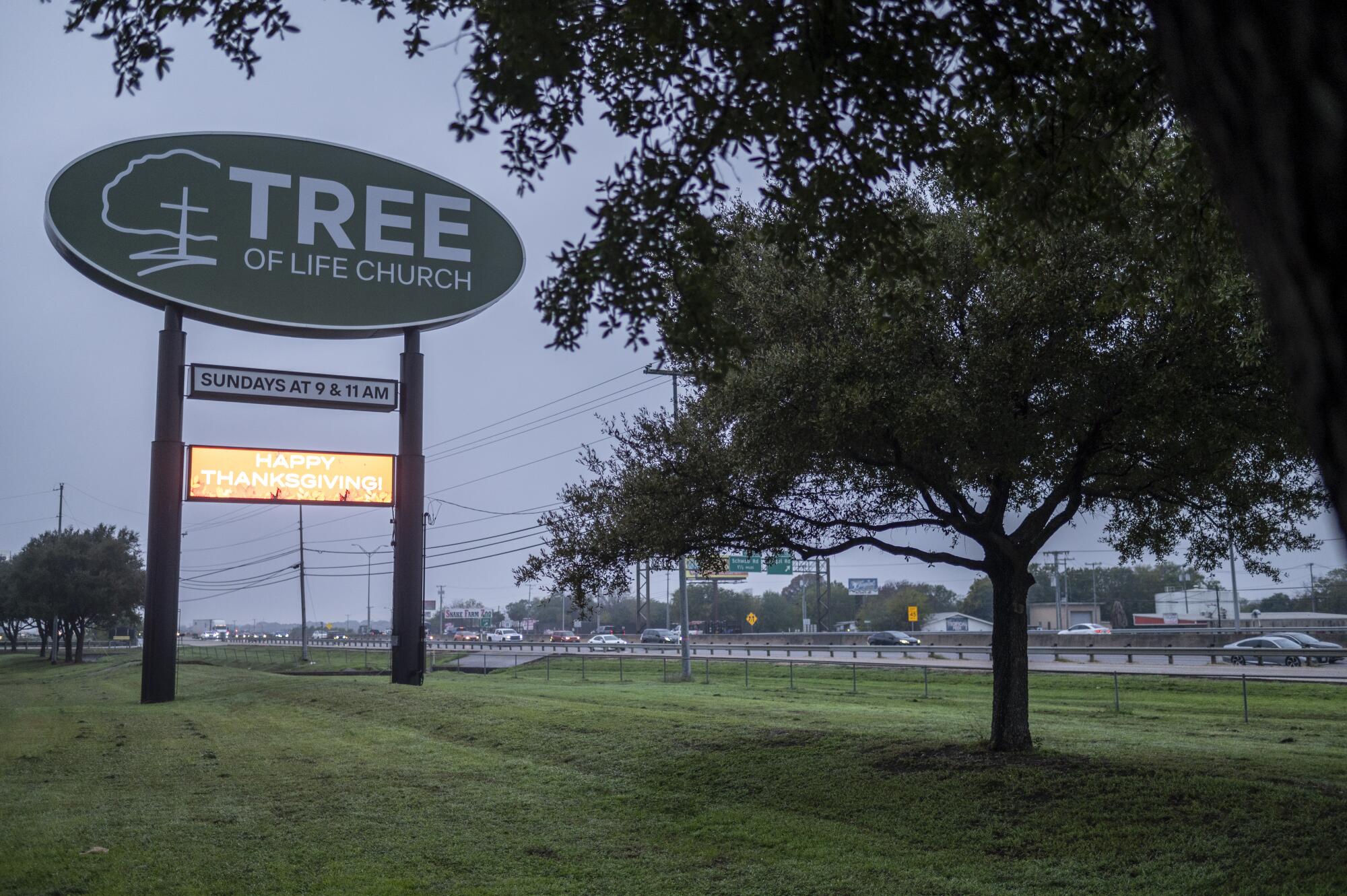
“A lot of people are looking for that structure, looking for a higher being to look for rather than it just being random chance, all this craziness — it’s looking for a compass that they can go to,” she said.
***
For Texans looking for such a structure, faith is a common answer. Religion is a more important compass for Texans, on average, than Californians, and that’s a major factor in the political differences between the two states.
When asked if it is necessary to believe in God to have good values, 47% of Texans said yes compared with 33% of Californians — a larger gulf than most other questions on the poll.
Texans are more likely than Californians to report going to church at least once a week and more likely to call religion important in their lives. Roughly half of Texans say religion is a major part of their identities, compared with just over a third of Californians.
Protestants, in particular, are a much larger part of the religious picture in Texas — 32% compared with 19% in California.
Not all religious people are conservative. But religious conservatives, especially evangelical Protestants, play a huge role in politics. Conservative churches serve as a place where like-minded people can share and reinforce each other’s views and mobilize for political action, much as unions, environmental groups and other civic organizations do on the left.
Religious identity has a big impact on many political issues, most notably abortion. Fifty-eight percent of Californians said they believed abortion should be legal in some or most cases, compared with 47% of Texans, the L.A. Times/YouGov poll found.
Just 12% of Texans believe abortion should be illegal in all cases, which is essentially what state law currently provides. In California, 9% said abortion should be illegal in all cases.
The gap is far wider between religious and nonreligious residents of both states.
In Texas, evangelical Christian groups hold enormous influence in the statehouse, in a way they do not in California.
Conversely, abortion-rights advocacy groups like Emily’s List and Reproductive Freedom for All (formerly NARAL Pro-Choice America) are major political players in California. When Gov. Gavin Newsom chose a new U.S. senator to finish the term of the late Sen. Dianne Feinstein, he chose Laphonza Butler, the president of Emily’s List from 2021-23 who was also formerly the head of the state’s largest union.
***
Whether the wide gap between Texas and California will persist could depend on the two states’ populations of color.
In both California and Texas, the political priorities of the state government largely follow the preferences of their white residents — a minority of the population, but still a majority of voters in both states. That pushes California further left and Texas further right.
That difference shows up on questions about policy as well as basic values. On the question of whether belief in God is necessary for a person to have good values, for example, Black and Latino Texans closely resemble Black and Latino Californians. In both states, the groups are fairly evenly divided.
White Californians, however, overwhelmingly reject that idea, 28% say yes to 65% no. White Texans are split, 42% say yes, 52% no.
Similarly, on abortion, a wide gap exists between the two states’ white populations. White Californians favor legal abortion in all or most cases by 20 points, 58% to 38%; white Texans oppose abortion in most cases, 44% to 52%.
By contrast, 48% of Latino Texans say abortion should be legal in all or most cases, as do 51% of Latino Californians. Fifty-nine percent of Black Texans say abortion should be legal in all or most cases, as do 63% of Black Californians.
A similar pattern of sharper ideological divides among white residents and much greater similarity between Latino and Black residents shows up on other issues, including attitudes toward guns, the poll found.
But change has been coming, slowly, to both states. As the voting populations grow more diverse, the poll indicates, these two states with so much in common could draw politically closer.
The Los Angeles Times/YouGov poll surveyed a representative sample of 1,599 adults, 760 living in California and 839 in Texas, online in English and Spanish, July 19-27. The samples were weighted according to gender, age, race, Spanish language use, education, party identification, current voter registration status, 2020 election turnout and presidential vote. The estimated margin of error is 5.2 percentage points in either direction for the California samples and 4.3 points for the Texas sample.
More to Read
Subscriber Exclusive Alert
If you're an L.A. Times subscriber, you can sign up to get alerts about early or entirely exclusive content.
You may occasionally receive promotional content from the Los Angeles Times.


